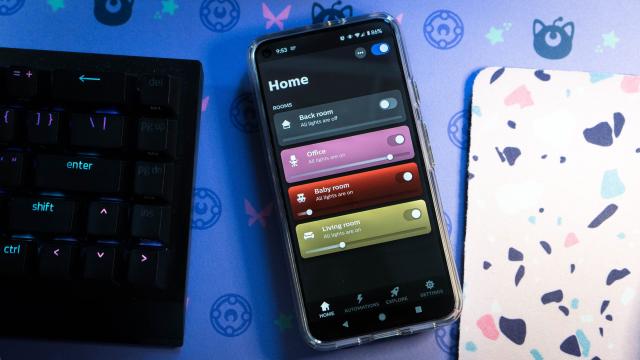It took four generations, but the Philips Hue app is finally a delight to use. In a significant update to its iOS and Android apps, which control its expansive lineup of smart lights and bulbs, Hue now has an overhauled interface and better automation engine, plus a few other subtle tweaks that make the entire experience more enjoyable overall.
I used the new Philips Hue app on a Pixel 5. From the first screen, the most notable change is the tinge on the interface. The buttons feature prominent shading to stand out as actionable against the relative flatness of the rest of the Android interface. Beyond that, the Hue home page remains unchanged in terms of content.
Tap on a room, and that’s when you’ll notice the real difference. The Hue app sports a new tile interface with quick access to pre-set scenes and the option to add on and customise your own. The Hue Scene gallery had existed before, but it was a bit of a mess. It looks better categorised in version four and a little less overwhelming to navigate.
Routines have also been revamped. They’re now called Automations. The Hue app will suggest a few to get you started, from setting the lights to sleep at night to having them gradually turn on before you come home. The feature uses geolocation, which you can set up through your device, though it will require configuring the Philips Hue hub for remote access. If you’re using an Android device, you’ll also have to enable the app to access location permissions and run in the background.
The rest of the Automation setup process is more helpful than the previous iteration. If you’re setting up your lights to turn on as you arrive home, for instance, the app will ask whether you want to run the automation every time or just in the evenings. The options were there before, but this time the onboarding process walks you through your choices, rather than tapping around the app to figure out what’s possible. You can then choose which rooms and which lights are affected by the automation. The Hue app will consider if someone is home already, so it doesn’t double up on automations or, say, turn off the lights for everyone else.
Ronald Geerlings, the Hue app’s global product manager, said during a press event that the team had made more than 100 improvements: The interface and automation changes were the “big” changes, while the “small” features are more prevalent in the settings. For instance, you can now manage multiple Hue bridges. The Entertainment Area has also been updated so that it’s more accurate at configuring numerous lights. It’s a handy feature if you plan to use Hue lights to frame your TV viewing experience. The new app includes a 3D view, where you can freely move lights around the room and even select their height and whether they’re bumping up or shining against an object. The Hue app will take care of the rest, like the colour of the lights and how they sync up with what you see on the big screen.
Smart home apps can sometimes feel like an afterthought. The app can enable all the necessities for controlling a gadget, but the interface can leave much to be desired, which is exactly what was happening with Hue. It’s why when you do a search for the app in either the iOS or Android app stores, a bevy of third-party apps appear alongside the official one. The Hue app was always capable of basics, like getting your smart lights online and changing the scene, but it lacked any visual interest. It also didn’t have the best reputation for smart home tinkerers who rely on routines and automated commands.
The new Philips Hue app is a significant improvement, and it’s a good indicator that the company is watching and learning what its users need to keep buying into its vast device ecosystem. The update is available for download now, and the app will also be updated later this summer with dynamic scenes, which will allow lights to cycle through different colours throughout the day.
